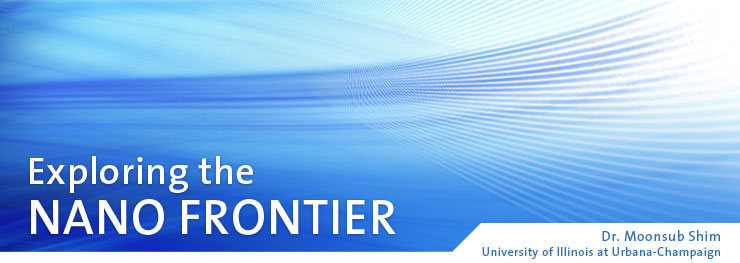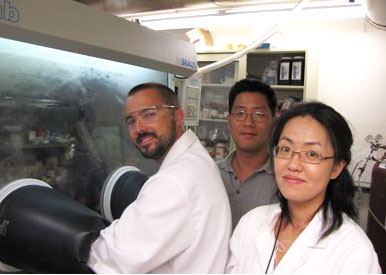


|
Structural Diversification of Anisotropic Nanocrystal |
Dr. Moonsub Shim is exploring a vast new frontier—on a nano-scale. "I like to understand phenomena that go on at the nanometer level with respect to electrons in various solids and then to take that knowledge to make materials with unique electronic properties," he says. "That's my inspiration."
At the University of Illinois at Urbana-Champaign, he and the graduate students in his laboratory study nanocrystals. Specifically, they study an emerging subclass called nanocrystal heterostructures (NCHs), in which two or more chemically distinct components are joined together epitaxially (meaning that the atoms on the interfaces of the materials maintain their orderly, crystalline structure).

Shim (center) with his graduate students Hunter McDaniel (left) and Bo Hyun Lee (right)
"In a nutshell," Shim explains, "We're trying to understand how such interfaces can form, and how we can exploit that to develop new materials or approaches for energy conversion processes."
Previous research in this field focused on what is known as the core-shell structure, where the outer shell encircles and enhances the properties of the core. Shim's research explores a newer direction, the non-core/shell, or anisotropic NCHs. These have more variety in their structure, for example, uni- or multi-directional growth of rods or dots from a nearly spherical seed material. The advantage of making the types of heterostructures that Shim is researching is that the unique properties of two or more materials can be easily combined with directionality while providing physical/chemical access to both components, leading to the potential creation of entirely new materials. Shim can assemble a dream team of molecules. "For example," says Shim, "You can combine the light-harvesting ability of the semi-conducting nanocrystals with the catalytic ability of metal oxide particles."

Dr. Shim's graduate students
In fact, this is one of the systems he is currently exploring, and he is excited about the practical applications. This particular system might help in developing new materials for photocatalysis, perhaps used to convert sunlight into clean hydrogen fuels. "Rather than just thinking about how electrons and holes might move around in these exotic nanocrystal materials, we want to take the next step," he says enthusiastically. "To start to think about how you can apply that to developing a catalyst that can help clean up the environment, or harvest energy from the sun."
For more in-depth information on Dr. Shim's topic, the Structural Diversification of Anisotropic Nanocrystal Heterostructures, go here.